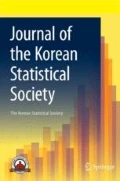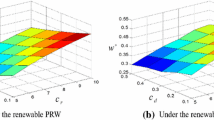Abstract
This paper proposes an optimal maintenance and warranty policy for the repairable second-hand product incorporating a periodic preventive maintenance strategy to slow down the deterioration of the product and derives an optimal length of non-renewing warranty period. Although a number of maintenance policies for the second-hand product have been discussed in the literature, there exist very few works dealing with the periodic preventive maintenance strategy under non-renewing warranty to obtain an optimal warranty period for the second-hand product. This work considers a non-renewing warranty policy, during which a periodic preventive maintenance is adopted to diminish the degradation process of the product and determines an optimal length of warranty period by optimizing the expected cost rate incurred to the dealer during the maintenance cycle. Since the replacement of the failed second-hand product may not be practical in general, we adopt a concept of full refund instead of replacement in this paper. By pre-setting a repair time threshold, either the refund or minimal repair is provided by the dealer depending on whether the failed second-hand product can be repaired within the repair time threshold or not. The maintenance cycle of the second-hand product starts with the purchase of the product and ends when either the refund occurs within the warranty period or the warranty expires. Given a certain cost structure charged to the dealer, we formulate the expected cost rate during the maintenance cycle of the product and determine an optimal length of warranty period minimizing the objective function. Assuming the power law process for the product’s failures and a Weibull distribution for the repair times, we present a numerical example and investigate the effects of periodic preventive maintenances and other relevant parameters on the optimal solution.


Similar content being viewed by others
Abbreviations
- PM:
-
Preventive maintenance
- ECR:
-
Expected cost rate
- RFRW:
-
Repair-full refund warranty
- RFRPW:
-
Repair-full refund preventive maintenance warranty
- cdf :
-
Cumulative distribution function
- pdf :
-
Probability density function
- T, Y :
-
Random variables representing failure time and repair time of the product, respectively
- \(F_{pm} \left( t \right),f_{pm} \left( t \right),h_{pm} \left( t \right)\) :
-
cdf, pdf, Intensity function, respectively, of T after being upgraded at each PM action during the warranty period
- \(F_{0} ( \cdot ),f_{0} ( \cdot ),h_{0} ( \cdot )\) :
-
cdf, pdf and intensity function, respectively, of the failure time for new product without PM actions
- \(H_{pm} (a,b):\,\mathop \smallint \limits_{a}^{b} h_{pm} \left( u \right)du\) :
-
Expected number of failures within an interval \(\left( {a,b} \right)\) when the PM action is adopted.
- \(G(y),g(y)\) :
-
cdf and pdf of the repair time Y, respectively.
- x :
-
Virtual age of the purchasing second-hand product corresponding to the reduced failure rate due to the upgrade prior to its sale.
- \(u_{x}\) :
-
Reduced calendar age that makes the virtual age equal to x
- \(\delta\) :
-
Inter-PM interval between two successive periodic PM actions
- \(\omega\) :
-
Length of warranty period
- \(\gamma\) :
-
Improvement level which measures the PM effect, i.e. \(0 \le {\upgamma } \le 1\).
- \(C_{m} ,C_{p}\) :
-
Random variables representing total minimal repair cost and total PM cost, respectively
- \(c_{o} ,c_{u} ,c_{m} ,c_{p} ,c_{f}\) :
-
Purchasing cost, upgrade cost prior to the purchase, unit minimal repair cost, unit PM cost and unit full refund cost, respectively
- \(r_{0}\) :
-
Repair time threshold
- \(t_{f}\) :
-
Time point at which a full refund is provided
- n :
-
Number of PM actions taken during the warranty period
- \(N_{{pm,r_{0} }} (a,b)\) :
-
Number of failures within an interval \(\left( {a,b} \right)\) when the periodic PM actions are adopted and the repair time threshold is set to \(r_{0}\)
References
Canfield, R. V. (1986). Cost optimization of periodic preventive maintenance. IEEE Transactions on Reliability, 35, 78–81
Chattopadhyay, G., & Murthy, D. P. (2000). Warranty cost analysis for second-hand products. Mathematical and Computer Modelling, 31, 81–88
Chattopadhyay, G., & Murthy, D. (2004). Optimal reliability improvement for used items sold with warranty. International Journal of Reliability and Applications, 5, 47–58
Darghouth, M. N., Chelbi, A., & Ait-kadi, D. (2017). Investigating reliability improvement of second-hand production equipment considering warranty and preventive maintenance strategies. International Journal of Production Research, 55, 4643–4661
Edmunds. (2019). Used vehicle outlook. https://static.ed.edmunds-media.com/unversioned/img/industry-center/insights/2019-used-vehicle-outlook-report-final.pdf.
Finkelstein, M. (2007). On statistical and information-based virtual age of degrading systems. Reliability Engineering and System Safety, 92(5), 676–681
Iskandar, B. P., & Husniah, H. (2017). Optimal preventive maintenance for a two dimensional lease contract. Computers and Industrial Engineering, 113, 693–703
Khatab, A., Diallo, C., & Sidibe, I. (2017). Optimizing upgrade and imperfect preventive maintenance in failure-prone second-hand systems. Journal of Manufacturing Systems, 43, 58–78
Kijima, M. (1989). Some results for repairable systems with general repair. Journal of Applied probability, 89-102.
Kim, D. K., Lim, J. H., & Park, D. H. (2015). Optimal maintenance level for second-hand product with periodic inspection schedule. Applied Stochastic Models in Business and Industry, 31, 349–359
Kim, D.-K., Lim, J.-H., & Park, D. H. (2017). Optimization of post-warranty sequential inspection for second-hand products. Journal of Systems Engineering and Electronics, 28, 793–800
Li, W., & Pham, H. (2005). An inspection-maintenance model for systems with multiple competing processes. IEEE Transactions on Reliability, 54, 318–327
Lim, J. H., Kim, D. K., & Park, D. H. (2019). Maintenance optimization for second-hand products following periodic imperfect preventive maintenance warranty period. Applied Stochastic Models in Business and Industry, 35, 1077–1089
Lo, H.-C., & Yu, R.-Y. (2013). A study of quality management strategy for reused products. Reliability Engineering and System Safety, 119, 172–177
Naini, S. G. J., & Shafiee, M. (2011). Joint determination of price and upgrade level for a warranted second-hand product. The International Journal of Advanced Manufacturing Technology, 54, 1187–1198
Park, M., Jung, K. M., & Park, D. H. (2020). Warranty cost analysis for second-hand products under a two-stage repair-or-full refund policy. Reliability Engineering and System Safety, 193, 106596
Pongpech, J., Murthy, D., & Boondiskulchock, R. (2006). Maintenance strategies for used equipment under lease. Journal of Quality in Maintenance Engineering, 12, 52–67
Rigdon, S. E., & Basu, A. P. (1989). The power law process: a model for the reliability of repairable systems. Journal of Quality Technology, 21, 251-260.
Sahin, I., & Polatoglu, H. (1996). Maintenance strategies following the expiration of warranty. IEEE Transactions on Reliability, 45, 220–228
Shafiee, M., & Chukova, S. (2013a). Maintenance models in warranty: A literature review. European Journal of Operational Research, 229, 561–572
Shafiee, M., & Chukova, S. (2013b). Optimal upgrade strategy, warranty policy and sale price for second-hand products. Applied Stochastic Models in Business and Industry, 29, 157–169
Shafiee, M., Finkelstein, M., & Chukova, S. (2011). On optimal upgrade level for used products under given cost structures. Reliability Engineering and System Safety, 96, 286–291
Su, C., & Wang, X. (2014). Optimizing upgrade level and preventive maintenance policy for second-hand products sold with warranty. Proceedings of the Institution of Mechanical Engineers Part O, 228, 518–528
Su, C., & Wang, X. (2016). Optimal upgrade policy for used products sold with two-dimensional warranty. Quality and Reliability Engineering International, 32, 2889–2899
Wang, X., Xie, M., & Li, L. (2019). On optimal upgrade strategy for second-hand multi-component systems sold with warranty. International Journal of Production Research, 57, 847–864
Yeh, R. H., Lo, H.-C., & Yu, R.-Y. (2011). A study of maintenance policies for second-hand products. Computers and Industrial Engineering, 60, 438–444
Zhao, X., He, S., & Xie, M. (2018). Utilizing experimental degradation data for warranty cost optimization under imperfect repair. Reliability Engineering and System Safety, 177, 108–119
Acknowledgements
Minjae Park’s work was supported by the National Research Foundation of Korea(NRF) grant funded by the Korea government(MSIT) (NRF-2020R1F1A104823711). Ki Mun Jung’s work was supported by the National Research Foundation of Korea(NRF) grant funded by the Korea government(MSIT) (NRF-2019R1F1A1049570). Dong Ho Park’s research was supported by Basic Science Research Program through the National Research Foundation of Korea(NRF) funded by the Ministry of Science (2020R111A1A0106654211). Minjae Park and Ki Mun Jung contributed equally to this work.
Author information
Authors and Affiliations
Corresponding author
Additional information
Publisher's Note
Springer Nature remains neutral with regard to jurisdictional claims in published maps and institutional affiliations.
Rights and permissions
About this article
Cite this article
Park, M., Jung, K.M. & Park, D.H. Optimal maintenance and warranty strategy for second-hand product with periodic preventive maintenance action. J. Korean Stat. Soc. 50, 773–794 (2021). https://doi.org/10.1007/s42952-021-00127-3
Received:
Accepted:
Published:
Issue Date:
DOI: https://doi.org/10.1007/s42952-021-00127-3




